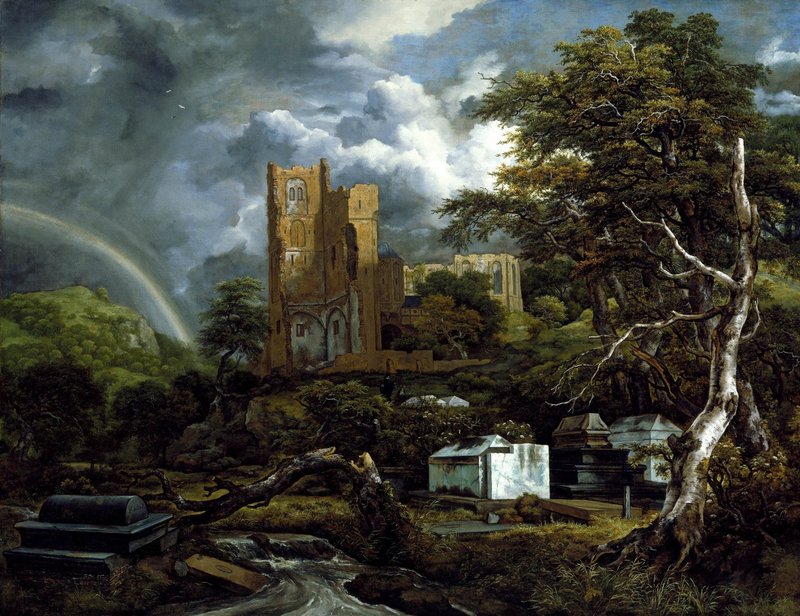
Words and visual patterns: in light of Gendlin and Langer’s discussions
When a painter borrows a motif, for example, a raggedy dead tree like those Ruysdael freshly created, could we say the motif is “used” like words are used? (Gendlin, 1997/2018, p. 178)
Maybe Gendlin was referring to the raggedy dead tree in the lower center of this painting below, wasn’t he?

Anyway, in the section ‘f-9) Discursive use versus art; re-eveving versus re-recognition’ (Gendlin, 1997/2018, pp. 178-9) in ‘Chapter VII-B: Protolanguage’ of “A Process Model,” Gendlin contrasts words and visual patterns. In particular, he emphasizes the quality of the visual patterns:
When the painter uses a Ruysdael tree, it is still the quality of the visual pattern that affects us. For example, if instead of the tree a little plaque were painted in, saying “dramatic desolate tree,” the effect would not occur. ... A word ... must work with other words not in terms of sound quality, but in terms of the system of other words and sequences which the word implies. (Gendlin, 1997/2018, p. 178)
Suzanne Langer, on the other hand, emphasizes the characteristic that words do not depend on sound quality:
For instance, if the word “plenty” were replaced by a succulent, ripe, real peach, few people could attend entirely to the mere concept of quite enough when confronted with such a symbol. The more barren and indifferent the symbol, the greater is its semantic power. Peaches are too good to act as words; we are too much interested in peaches themselves. But little noises are ideal conveyors of concepts, for they give us nothing but their meaning. (Langer, 1942/1957, p. 75)
Gendlin argues that “the tree also has to work together visually in terms of line and color patterns with the rest of the painting” (Gendlin, 1997/2018, p. 178). Langer also makes much the same claim that visual forms present their constituent elements simultaneously:
Visual forms—lines, colors, proportions, etc.—are just as capable of articulation, i.e. of complex combination, as words. But the laws that governs this sort of articulation are altogether different from the laws of syntax that govern language. The most radical difference is that visual forms are not discursive. They do not present their constituents successively, but simultaneously, so the relations determining a visual structure are grasped in one act of vision. (Langer, 1942/1957, p. 93)
In the passage above, Langer’s argument that it is “not discursive” to present the constituents simultaneously rather than successively is probably related to her statement that the characteristic of “discursiveness” has traditionally been thought of as follows:
... words have a linear, discrete, successive order; they are strung one after another like beads on a rosary …. ... we cannot talk in simultaneous bunches of names. (Langer, 1942/1957, p. 80)
... all language has a form which requires us to string out our ideas ...; as pieces of clothing that are actually worn one over the other have to be strung side by side on the clothesline. This property of verbal symbolism is known as discursiveness .... (Langer, 1942/1957, p. 81)
However, Gendlin notes that not all words function as discursive symbols, “It doesn’t matter about the sounds, except in poetry-which is again a type of art.” (Gendlin, 1997/2018, p. 178)
Langer also mentions that poetry has non-discursive characteristics:
The material of poetry is discursive, but the product—the artistic phenomenon—is not; its significance is purely implicit in the poem as a totality, as a form compounded of sound and suggestion, statement and reticence, and no translation can reincarnate that. (Langer, 1942/1957, pp. 261-2)
The above is why my introduction to Gendlin and Langer’s arguments does not address what Gendlin most wanted to argue in the next section, “f-10) New expression” in “Chapter VII-B: Protolanguage,” which is as follows:
When language developed, there was also a split between language and art. This split is because of the self-enclosed (I also call them “discursive”) units of language, in contrast with the new visual and sound expression that a new work of art always is. (Gendlin, 1997/2018, p. 180)
However, I am confident that it may be helpful to at least understand “f-9) Discursive use versus art” as a preliminary step to “f-10) New expression”.
References
Gendlin, E. T. (1997/2018). A process model. Northwestern University Press
Langer, S.K. (1942/1957). Philosophy in a new key: a study in the symbolism of reason, rite, and art (3rd ed.). Harvard University Press.
Ruisdael, J.v. (1654-5). Jewish Cemetery.
この記事が気に入ったらサポートをしてみませんか?
